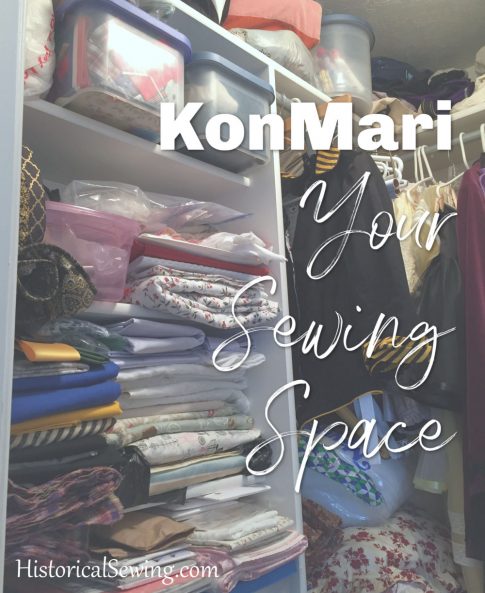
So, in case you haven’t heard, there’s the classic New Year’s trend of cleaning out your house going around, and currently it’s using the KonMari Method (thanks Netflix!).
KonMari was created by Marie Kondo from her book The Life Changing Magic of Tidying Up. Her follow-up book, Spark Joy, addresses all those hanging questions that come up from reading her main book on tidying. She even backtracks her own belief that everyone should only have one shelf of books, and other crazy – to us – ideas based on her Japanese culture. I mean, BOOKS – hello! I love them and won’t purge them (much).
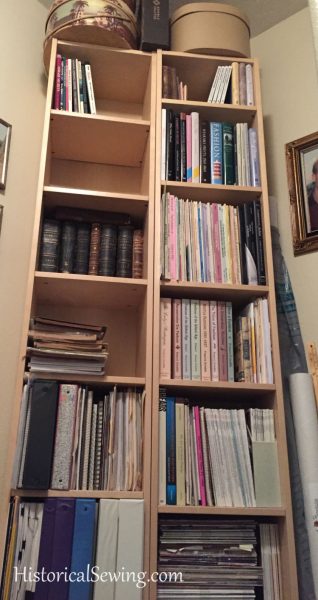
However, I have found a positive change from her method in regards to my possessions and how I take care of them (or don’t). I’ve KonMari’ed most of my house, except my kitchen, which I feel in control of and enjoy what I own.
Yes, I haven’t gone through my sewing room and costuming stuff in that full KonMari way of REALLY decluttering and holding on to those things that give me joy.
But, it’s time.
Enough of keeping up with the storage of old costumes I can’t fit into and the fabrics piled up that simply clutter my living space and my mental space, which is holding me back from new creative work! Do you feel that way too?
I know KonMari isn’t everyone’s gig.
Some think it’s minimalism (it’s not).
There’s no specific number of things to keep or discard.
Some complain about how their toilet paper or ibuprofen doesn’t “spark joy” but they’re keeping it anyway (right?).
It is NOT getting rid of stuff just to get rid of it. It’s keeping those things you WANT. No matter the amount. For me it’s six bins of fabric; for you it could be 17.
Listen… Kondo’s definitive “spark joy” question you ask about each possession is not absolute. It’s fluid and open to interpretation of what YOU believe.
Yes, there are items you own that give you joy and you wouldn’t live without. Yet, other items that in-and-of-themselves don’t give you happiness but are truly useful in your life. They make your life easier. These things you keep even if you don’t get warm fuzzy feelings of joy. Got it?
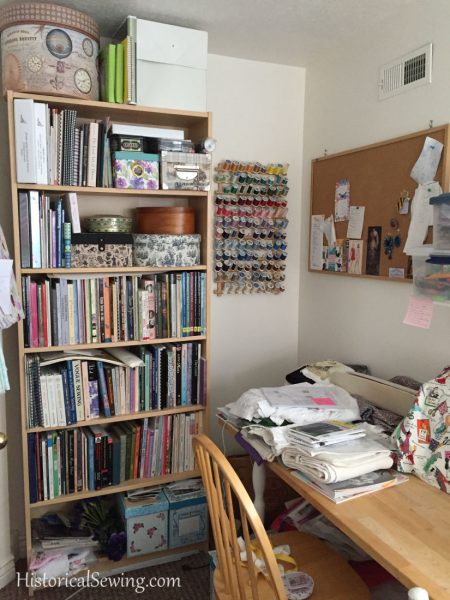
So let’s start looking at our sewing room or space.
Remember this: EVERY ITEM has come into your life for a purpose.
You may be using something and you like it. You may be saving something you still like for later use so you keep hanging on to it.
Yet, there are things in your sewing area, like mine, that have outlived their usefulness or purpose in your creative endeavors. There are things that need to move on so someone else can give them purpose. Or you toss them because you’re done dealing with them and they are not working for you anymore.
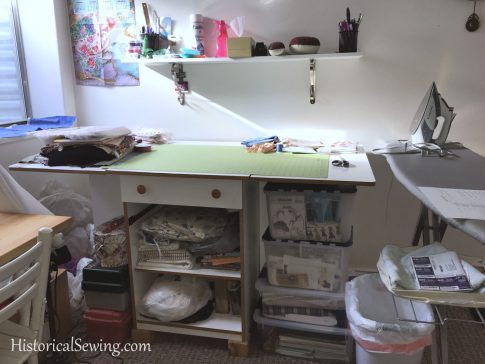
The First Priority
I’ll admit I’ve skimmed over this step with my house. (It’s why I need to KonMari my house again…)
But with my sewing room I need to find my creativity again. It’s been kinda dry with my sewing for a while and would like to “clear the space” (both physical and mental) for projects I really want to do at this point in my life. You??
The official questions:
What is your vision for your sewing?
What do you want to do with your hobby of sewing? What kind of costumes do you want to make? What are you inspired to do now and not “someday?”
Really understand how you want your sewing room to work for you…. rather than controlling you by taking up space and cluttering your house and mind. How much do you want your stash to make it easy for you to create and inspire you to sew?
Once you understand what you want out of your sewing and costuming hobby you can then begin to declutter your fabrics, notions, books, tools and such to help you pursue your creative ideas.
As you go through the “spark joy” process, it will absolutely look quite messy before it gets better. Hang in there. Don’t get anxious.
Keep your vision clear of where you want your tidying to go and what you want your sewing stuff to look like after the tedious process of cleaning.
Ready to go??
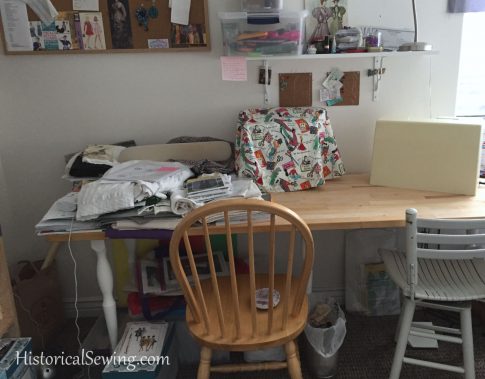
The KonMari Method breaks down your possessions into five basic categories and you go through each separate category, one item at a time.
The categories are designed in a specific order so as you sort your items you get better at knowing that which gives you joy and/or is useful to you and you want to keep it. You work at refining your decision making.
Kondo’s categories: 1) Clothes, 2) Books, 3) Documents/Papers, 4) Komono/Misc, and 5) Sentimental. I’ll apply her categories to sewing as a hobby, which falls under the Komono category. So, if you’re using KonMari for house tidying, save the sewing/hobby stuff for last. Or do it when you get to this miscellaneous category.
My category recommendations for sewing/crafting areas:
- Clothes – this would be finished costumes and other projects. However, I know you’re thinking, “how am I going to choose which costumes spark joy?” so I’m going to say you put all finished “clothing” items (costumes, hats/bonnets) and created projects within your sewing space to the very end in the Sentimental category. It’s hard to make decisions on those projects we’ve put our blood, sweat and tears into. Work on other categories first so you get the hang of joyful decision making.
- Books – all books you own and use for sewing and craftwork.
- Documents/Papers – sewing patterns (published and custom), pattern papers, magazines, notes, binders, etc.
- Komono/Misc – everything else essentially. But break it down further:
- Fabric
- Trims
- Notions
- Sewing Tools
- Anything else you have as a category in your sewing/crafting space
- Sentimental – finished projects and costumes, “clothing” as part of your sewing (such as undergarments and headwear), works-in-process (WIPs), photos, awards, and convention memorabilia.

So, now that we’ve got a guide of how to proceed, let’s get to it!
As I’ve mentioned earlier, the KonMari method is designed and should be followed in category order, however, I think it’s open to interpretation as to how you, individually, want to approach it.
Start with books then proceed through the above list. Or start with sewing Komono and do books later. Start with that category that you believe will be easiest for you to go through and make decisions to keep or discard.
A note on discarding: the items you don’t want to keep can be either donated, sold or trashed. Don’t worry too much on this now… or start separate piles for discards as you move through your things. Keep garbage bags handy!
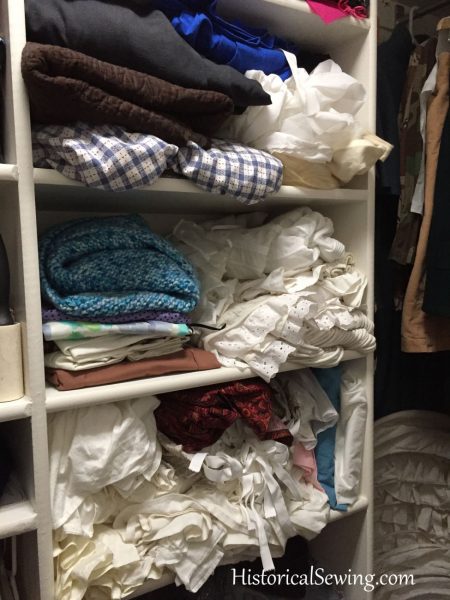
This is the tough work now! Focus on your vision of your desired sewing space with all the things in it to provide inspiration to you.
Also… don’t think of storage options as you purge and do the “spark joy” test. Only after you’ve parred down and decided what to keep will it be time to figure out where to put that category of items.
- Pull out EVERYTHING in one category, from wherever in the house and pile up.
- Pick up each item and determine if it gives you joy to own, provides a purpose for your sewing (both now or for a future project), or is useful and makes your projects easier.
When you pull all your scissors together or pile up ALL those sewing patterns or stack up the yards of fabric you realize how much you have (or don’t as is sometimes the case), then you really can concentrate on what you want to keep as it gives you joy or will be useful for a project you have in mind.
Do you really need seven seam gauges, or will four do?
Or you find things you knew you had but hadn’t been able to find.
That pattern you picked up years ago has no joy for you now because you are not sewing that style or time period.
When the thought comes (and it WILL) about: “What if I need it later on?” then decide if that future project still gives you the same spark as when you first gravitated to it and you still want to make/use it or not.
Remember, tools are helpful and make (sewing) life easier for us. Just because that grommet setter has been used only once and you have no joy in it, think if it will be useful for a future project and keep it. Or if you have no plans to set grommets in the future then discard.
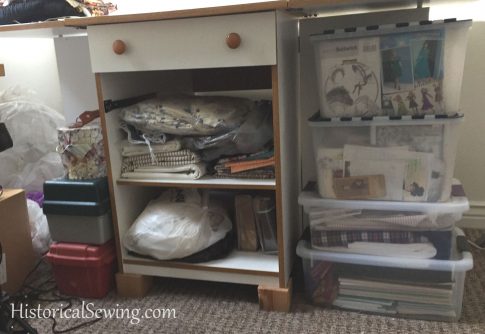
Don’t hold onto things “just because” or for “someday.”
This is like WIPs or UFOs – those projects you’ve started but not yet finished. Ask yourself (in the spark joy mindset) if you still want to finish it, or if you’ve moved past the project? Don’t limit yourself to past projects left undone if your life has moved beyond it and your interests TODAY are focused on other plans.
I’m going to start with my notions and patterns because I feel I’ll be able to decide if those things “spark joy” easier than my fabric stash and trims. This is why the costume closet will be done last. Sentimental items ARE hard to discard. Refine the process with stuff that’s not as close to your heart first.
So, go through the category list, one at a time. Gather EVERYTHING in that one category onto your table or bed or floor. Don’t start sorting items until they have all been gathered up.
Then go through each item and decide if you want to take that item into the future with you. Or if has served its purpose in your life and it’s time to move on.

One aspect of KonMari is having gratitude for your possessions.
Those things that have served you in the past but aren’t traveling into the future with you need to be let go with thankfulness.
Some may see this as “woo-woo” in her method. However, there is something cathartic in releasing items with appreciation as they have helped you through life until this point in time.
Whether you meditate on each item as it’s discarded or speak out loud to it (“thank you”), take in some closure as you discard.
After all categories have been gone through, even that fabric stash, decide how you want to store for the best access and inspiration for each.
I won’t go into Kondo’s folding method here, but rolling/folding fabric and standing up within bins sounds like a neat idea I’d like to try rather than keeping my yardage in flat folds stacked up in those bins.
I am just starting on using KonMari on my own sewing room. Take the journey with me – be it a few weeks long or a couple months.
Do each category all at once even if it takes a few days. Challenge yourself.
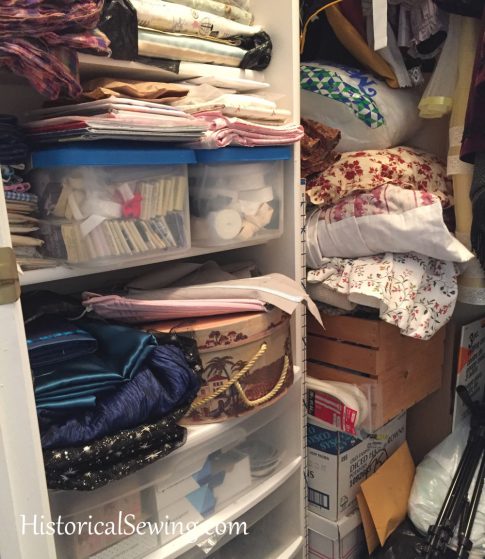
I’m doing it to clear my mind and physical space so I can get back to the sewing projects I love to make. I’m tired of being bogged down by “stuff” and that includes my sewing and craft supplies. (Most of the photos in this post I took before writing this post so I can see what I’m starting with and compare when I get finished.)
How about you? Ready to tidy? 🙂
P.S. Listen to my full podcast episode on this topic.
P.P.S. You’ll find storage ideas and tips in this post.
P.P.P.S. This “Spark Joy” podcast episode breaks down myths and missteps of what people believe about the KonMari method, with tips on how to keep anxiety away and know we are working in our own particular method.
Have you done a KonMari declutter with your sewing/craft room? Would you like to? I’d love to hear your ideas and thoughts on this process!


I enjoyed reading this post. Over the last couple months I have been weeding through the stash of fabric and craft supplies I have accumulated over the last 15 or so years. This isn’t as overwhelming as some may think, having moved a few times and this purging along the way.
I am looking forward to, soon, having a studio space for sewing, bookbinding, and printmaking. Having an all to me closed off space is exciting, but finding proper storage is a must especially since I can design the space from the ground up.
That being said I discovered, what I hope will be a good solution for my particular needs, Ikea wardrobes or the Pax closets. The larger drawers are big enough for a substitute flat file drawer, those needed for proper storage of large format paper. I also had the idea to hang my fabric yardage similarly to the way velvet is hung in the fabric store.
I know that cost can be an issue, as it is for many of us. The Ikea website has a planner that is easy to use and allows you to see what you need and preplan. Once that is done you can see the cost and figure out how to break it down into manageable chunks or buy a few pieces at a time.
Modular systems like these can be taken apart and reassembled when needed, if you are careful that is. I have three international moves that prove this.
I hope this helps someone out there.
How wonderful to be able to design your sewing space! Have fun doing so. Thanks for all the ideas. Ikea items are fabulous!
Very timely article and podcast. I enjoyed both! I’m a long time sewer and now mostly quilter in need of decluttering my sewing space. Having read the Marie Kondo book and then watching the Netflix series I have been thinking about applying the method to my sewing and quilting room. Your thoughts have helped me gain some clarity in how to approach it this way.
I think it comes down to visualizing what you want and realizing what is a burden. It’s so hard for me with fabric…it holds so many possibilities yet. My tastes in colors and styles has changed over the years. It is time to let go of what is not my favorite today (even tho I can envision it in a lovely scrap quilt). I see my future sewing mostly gifts and donation quilts but if I don’t love the fabric I’m sewing it may just be
better to release it to others to sew. I want to be able to walk in my sewing room and not have to step
around bins of fabric and have so much that it overwhelms me and I walk out and don’t sew anything.
It is very hard to separate joy and usefulness when it comes to fabric and notions. I am preparing to reduce my stash by at least half over this journey. I think I can do it. I can’t throw it away tho. I’d love to hear ideas you may have about donating.
Yes to these thoughts! I’m currently going through my trims and have the same issues of letting go when it could still be useful for another project I *might* make in the future. It can be really tough with some pieces.
Donations: local theater groups; a local quilting/sewing group that makes blankets for newborns; historical societies or living history museums might have ideas; I have friends making dresses for Dress a Girl Around the World but other organizations similar to this may take donations.
Timely article. I started reorganizing my sewing stuff because I COULD NOT FIND ANYTHING when I needed it. My sewing “space” is not a space at all, as my S.O. has edged me out of the “office” where he now has all his HAMM radio stuff, and we got a new puppy, which requires everything be out of puppy reach.. The only space left with enough light is the dining room (not optimal), so every time we had company, I had to dismantle my sewing station. Everything ended up in grocery bags, stuff randomly into closets. Now I’m taking it all apart, slowly. I found one missing item, still need to find others, and I’m looking at the stash in a new way, taking fabric from projects I no longer care to create and looking to repurpose. It is a struggle and will probably take a few more months, but already my mind is feeling clearer and I can FIND THINGS now. my big thing is …scraps! I just want to hang on to every scrap “in case I need it”. Will work on that.
Yay for cleaning and finding lost things AND for the mind feeling clearer! That is so important. And I agree that this process can take a few months. Keep at it! 🙂
I love Marie Kondo and her show on Netflix. I’ve started on my apartment. I needed a new TV for my sewing room which inadvertently led to a pretty deep sort and clearout/rearrangement of my space as the tv was bigger than I thought, wouldn’t fit on either of the tv stands I had and required some quick changes of plans.
The good news is that I’ve finally gotten stuff rearranged to a point where I can get back to work and I’m motivated to get projects on the move now!
Yay!!
I love this, Jennifer! Moving from South Africa back to the States forced me to “KonMari” all my sewing stuff before I had ever heard of Marie Kondo, but now my kids and I are loving her Netflix series and having a lot of fun organizing our spaces. I enjoyed seeing how you approached this method from your own unique circumstances, and I love the results. Inspiring!
Thanks. And I can’t even imagine an international move! Interstate is rough enough.
Yes! Tiding my whole house is a goal this year. Thanks!
Last summer I spent over a week washing, ironing and organizing my fabric that I use for making cloth dolls and doll clothing. I work on a smaller scale than you. One thing I did was to buy magazine boards from Amazon. I got about 200 of them. What you do is fold your fabric and roll it up on the boards either vertical or horizontal. You then stand the boards up on a shelf side by side sort of like books. I organized according to color solids, plaids, gingham, novelty’ knits and party. That way you can at once see what fabric you have without having to go thru bins looking for something that is hidden at the bottom. Smaller fabrics like fat quarters are folded and placed in plastic containers standing up so once again you can see what you have. I do believe there is probably a you tube video to show you how to do this. I bought the magazine cardboard boards because they are a bit bigger than the comic book ones.
I’ve seen that folding method for fabric. Looks great!
Two years ago I cleared a lot from my sewing (clutter) room. I had to make it a dual sewing/guest room. I broke down and got rid of my big cutting table (sad but necessary). Sent a big cabinet to a new home, rearranged the remaining cabinets and bookcases I had left, bought a new corner “desk” that been a great sewing machine table with space for clear shoebox drawers for notions. I got a big folding table to use for cutting and laying out projects while I worked on them. Not as wonderful as my big cutting board gone on to another home, it still functional. And it folds and stores away under the futon while the room functions for a guest room. I put up shelving on the wall high up above the futon which is piped back to a sofa in sewing room mode. Of course, sewing stuff gets piled on there . Last year I got various sizes of plastic bins and put all the items bought (or pulled out of the stash) for each project I have currently on my project list and labeled them. ( surely I’m not the only one who switches between projects due to changing deadlines and pop up projects. That way I just put all the items for one project back in the bin and close it up. Everything is together when I get back to it.) I did whittle my book and pattern collections down some. To say the room is snug is true, but very functional. It takes me about a full day to change from sewing room to guest room if I am in the middle of a big sewing project, but it does work well for both. I still need to go through the fabric stash again with eyes on new projects planned. I have fabrics from years ago that aren’t going to be used for the original project. I actually found some big yardages perfect for the new style and time period I’m into, so $$$ saved on buying some fabric.
All to say, I have worked through decluttering my sewing room. But more is needed. More will happen. Thank you for being “one of us” and taking us along with you on your sewing journies.
Appreciate you sharing your storing methods!
I did this a few years ago and it was amazing! I had kept so many bits and bobs that I thought I’d use “some day” when that really meant never. And I sold off a bunch of vintage patterns that I either had already sewn or didn’t excite me like they did when I bought them. Yay for space and funds for patterns that actually excite me right now. Costumes were the hardest to let go of but I did end up donating some of them. I still have nice pictures to remember each of them and I have my closet space back.
It’s really interesting how our tastes and styles evolve over the years (not to mention the shape of our bodies!). It is nice to get a fresh start to invest in what we love now and not be bogged down by the past as much.
Yes! Exactly all this. <3
Thank you for outlining the process: I’ve heard of it but never knew the details.
I started tidying last fall, but lost steam. You’ve refilled the boiler 🙂 Tomorrow morning, back at it, with a logical process to follow!
By the way, I gave several costumes away and they made people happy. Which thrilled and made me grateful.
Very best,
Natalie
Yay! You are welcome. And best of luck as you move forward. My own costumes will be tough for me but it needs to be done. Having gratitude during the whole process works wonders on our spirits. 🙂
For the last nearly-10 years, I’ve not had a permanent sewing room–I have sewing storage, and am portable around the cottage instead. But that storage is… well, inchoate is a polite way to describe it. 😀 So yes, I’ll join you on this adventure! Right after our Burns’ Supper gig next weekend, because I have a kilt to finish before then. I’m very much looking forward to lightening the load, restoring order to what’s needful, and experiencing that burst of creative joy that comes through being tidy! I create SO MUCH MORE in tidy spaces. Honestly, I think learning to Work Tidy over the last 20 years has been one of the best things I could have ever done for myself! Realizing I don’t have to dwell in chaos, and that I create more when I’m not in chaos, has been fantastic and revelatory for me.
Sounds fantastic! I do have “organized piles” at times, but I’m so looking forward to getting the excess stuff that I don’t use or won’t use in the future, gone. Good luck with your own tidying!
This is so timely! I just finished a *huge* push–dress, overdress, cap and veil–for an SCA event. Two weeks of flurry to finish and my sewing room is a mess! While I probably won’t be using the KonMari method, I appreciate the kick in the pants this post is giving me.
Yay! I’m happy to hear you are motivated to get it back in order… no matter how you go about doing it. Organization in the sewing room allows for more creativity. 🙂
Elsie, I am in SCA in K. Of Atenveldt, what is a push-dress? Never heard of it. What period?
I just found this site. Daughter is helping clean and reorganize sewing room. She told me to give way 50% of my books.. Almost done. WIPs in another room to do. We have to gatb her for Estrella War as she is moving from Steampunk in NY to SCA here in AZ. So have to make room for two in the room.
Welcome to our Joyful Community, Linda/Isabelle! Good luck with your decluttering. 🙂
Linda/Isabelle –
I’m not certain, but I read that as “a huge push to make a dress, overdress, cap and veil for an SCA event”. I’ve been in the SCA (West) for 40 years, and I don’t think there IS such a thing as a “push-dress”!
This is so timely. Every winter break, I “attempt” to clean up the sewing room, but I always avoid my patterns. Once again, I totally ignored the three wicker cabinets (three drawers each) of patterns. Thank you so much for doing this! I can’t wait to have more storage space.
Oh, and yes, I do need all those seam gauges….they tend to scatter around so there are only one or two left in my “seam gauge” cup when I get into a project – LOL. They bring me GREAT joy.
I LOVE my seam gauge! One of my favorite tools, and it’s good to have them spread around in all the places you sew. 😉
I like the way you break this down for sewing rooms. I sort of did it before I moved last year so there wouldn’t be as much to move, but everything got thrown in my new sewing room to unpack. It’s functional I suppose…. Time to start this in my newish space! Thanks for writing this!
You’re welcome! Good luck!
I was waiting for someone to put out a konmari post for sewing! I started onmy sewing area between Christmas and new years and so far it is happening slowly. My goal is to be completely finished before March! I am also organizing and swatching my entire fabric stash!
Huzzah! Best of luck to you! 🙂
Great post to focus in her key points in the sewing room. I read her books in 2017 and did my entire house and it was great. I even tackled my sewing/crafts and donated ALL of the donate to a high school seamstress I met at a local german festival while selling dirndls. She loaded up with a full station wagon of my discards lol. It was so freeing AND I was so happy to see her at a regency event I hosted wearing a handmade dress from fabric I probably bough 10years ago. Since we’ve moved I’m in the process of doing it again. I started earlier this week and I’m videoing the whole craft room make over for a time lapse 🙂
I took 20 photos of my sewing spaces (some of them shown in this post) so I’d have a look-back at where I started. And fun to see someone use your old fabric you didn’t want! That’s cool.